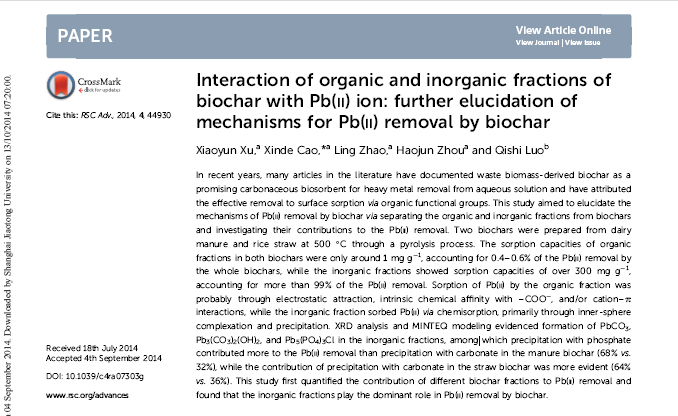Interaction of organic and inorganic fractions of biochar with Pb(II) ion: further elucidation of mechanisms for Pb(II) removal by biochar
2017-11-27
Xiaoyun Xu, Xinde Cao, Ling Zhao, Haojun Zhou and Qishi Luo
Abstract
In recent years, many articles in the literature have documented waste biomass-derived biochar as a promising carbonaceous biosorbent for heavy metal removal from aqueous solution and have attributed the effective removal to surface sorption via organic functional groups. This study aimed to elucidate the mechanisms of Pb(II) removal by biochar via separating the organic and inorganic fractions from biochars and investigating their contributions to the Pb(II) removal. Two biochars were prepared from dairy manure and rice straw at 500 through a pyrolysis process. The sorption capacities of organic fractions in both biochars were only around 1 mg g-1, accounting for 0.4–0.6% of the Pb(II) removal by the whole biochars, while the inorganic fractions showed sorption capacities of over 300 mg g-1, accounting for more than 99% of the Pb(II) removal. Sorption of Pb(II) by the organic fraction was probably through electrostatic attraction, intrinsic chemical affinity with –COO-, and/or cation–p interactions, while the inorganic fraction sorbed Pb(II) via chemisorption, primarily through inner-sphere complexation and precipitation. XRD analysis and MINTEQ modeling evidenced formation of PbCO3, Pb3(CO3)2(OH)2, and Pb5(PO4)3Cl in the inorganic fractions, among which precipitation with phosphate contributed more to the Pb(II) removal than precipitation with carbonate in the manure biochar (68% vs. 32%), while the contribution of precipitation with carbonate in the straw biochar was more evident (64% vs. 36%). This study first quantified the contribution of different biochar fractions to Pb(II) removal and found that the inorganic fractions play the dominant role in Pb(II) removal by biochar.
through a pyrolysis process. The sorption capacities of organic fractions in both biochars were only around 1 mg g-1, accounting for 0.4–0.6% of the Pb(II) removal by the whole biochars, while the inorganic fractions showed sorption capacities of over 300 mg g-1, accounting for more than 99% of the Pb(II) removal. Sorption of Pb(II) by the organic fraction was probably through electrostatic attraction, intrinsic chemical affinity with –COO-, and/or cation–p interactions, while the inorganic fraction sorbed Pb(II) via chemisorption, primarily through inner-sphere complexation and precipitation. XRD analysis and MINTEQ modeling evidenced formation of PbCO3, Pb3(CO3)2(OH)2, and Pb5(PO4)3Cl in the inorganic fractions, among which precipitation with phosphate contributed more to the Pb(II) removal than precipitation with carbonate in the manure biochar (68% vs. 32%), while the contribution of precipitation with carbonate in the straw biochar was more evident (64% vs. 36%). This study first quantified the contribution of different biochar fractions to Pb(II) removal and found that the inorganic fractions play the dominant role in Pb(II) removal by biochar.
